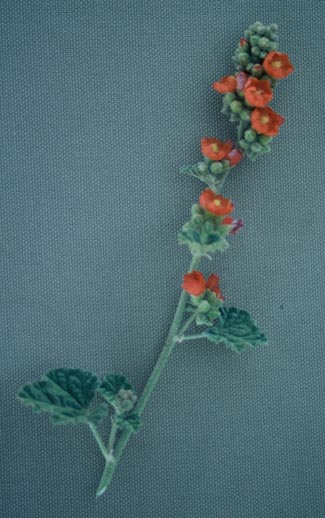Gooseberry-Leaf Globemallow

Common Name(s):
Gooseberry-leaf Globemallow
Gooseberry Globemallow
Currant-leaf Globemallow
Scientific Name:
Sphaeralcea grossulariifolia (Hook. & Arn.) Rydb.
Scientific Name Synonyms:
None Known
Symbol:
SPGR2
Description:
Life Span: Perennial
Origin: Native
Season: Cool
Growth Characteristics: Gooseberry-leaf globemallow is a hairy, several -stemmed forb which grow from a woody base. It is covered with a fairly dense covering of star-shaped hairs, giving the plant a grayish or gray-green cast, and grows up to 24 inches tall. Flowers April to August, and reproduces from seeds.
Flowers/Inflorescence: The coral to orange and apricot colored flowers are found in short, dense terminal spikes, or the lower flowers may be in the leaf axils. The bell-shaped calyx is fairly densely covers with star-shaped hairs. The calyx ranges from 5-6 mm long with broadly lance-shaped lobes. The petals range from brick-red to apricot and are up to 1 inch long.
Fruits/Seeds: Schizocarp.
Leaves: Gooseberry-leaf globemallow leaves are circular in outline and deeply parted into 3-5 thin lobes which are again deeply cleft. The blades range from 1-4 inches long and about as wide. The petioles of the lower leaves are up to 2 ½ inches long with those of the upper leaves shorter. The leaves are green to green-gray with white hairs.
Stems: Gooseberry-leaf globemallow has clusters of spreading to erect, simple to branched stems, from 15 to 35 inches high.
Roots: Deep-seated running roots.
Ecological Adaptions:
Gooseberry-leaf globemallow grows mainly on dry plains, open deserts, washes, playas, hillsides, foothills, mesas and canyons at elevations from 2,600 – 7,500 ft. It is considerably drought resistant and establishes well on disturbed sites. It loses its leaves during times of drought and may actually increase in size in times of drought and overgrazing. Of all the globemallows, Gooseberry-leaf globemallow occupies the more arid end of the habitat.
Soils: Grows in soil textures ranging from clay to gravel. It can grow in alkaline soils and tolerates moderate salinity. It is often found on volcanic soils.
Associated Species: Shadcale, cheatgrass, big sagebrush, blackbrush, greasewood, rabbitbrush.
Uses and Management:
Gooseberry-leaf globemallow is a desirable forage species for some livestock and wildlife, in part because it is drought resistant and often remains green throughout the summer.
It is one of few native forbs suitable for seeding on disturbed, exposed and erodes sites in harsh environments in the Intermountain West. It can be used to suppress cheatgrass and other annuals. For its aesthetic qualities, it is recommended for landscaping in arid environments.

